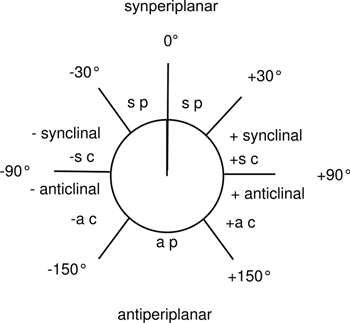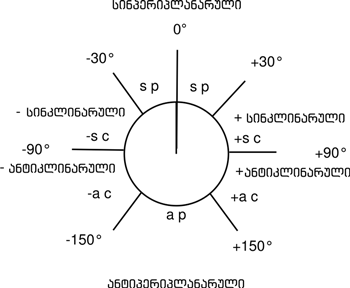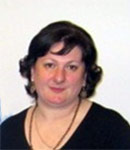ქიმიის ტერმინთა განმარტებითი ლექსიკონი
- ინგლისურ-ქართული
- ქართულ-ინგლისური
- ლექსიკონის შესახებ
- გამოხმაურება

| torsion angle | გრეხვის კუთხე |
| In a chain of atoms A-B-C-D, the dihedral angle between the plane containing the atoms A,B,C and that containing B,C,D. In a Newman projection the torsion angle is the angle (having an absolute value between 0° and 180°) between bonds to two specified (fiducial) groups, one from the atom nearer (proximal) to the observer and the other from the further (distal) atom. The torsion angle between groups A and D is then considered to be positive if the bond A-B is rotated in a clockwise direction through less than 180° in order that it may eclipse the bond C-D: a negative torsion angle requires rotation in the opposite sense. Stereochemical arrangements corresponding to torsion angles between 0° and ±90° are called syn (s), those corresponding to torsion angles between ±90° and 180° anti (a). Similarly, arrangements corresponding to torsion angles between 30° and 150° or between -30° and -150° are called clinal (c) and those between 0° and 30° or 150° and 180° are called periplanar (p). The two types of terms can be combined so as to define four ranges of torsion angle; 0° to 30° synperiplanar (sp); 30° to 90° and -30° to -90° synclinal (sc); 90° to 150°, and -90° to -150° anticlinal (ac); ±150° to 180° antiperiplanar (ap).
|
A-B-C-D ატომების ჯაჭვშ, A,B,C ატომების შემცველ სიბრტყესა და B,C,D-ს შემცველ სიბრტყეს შორის ორწახნაგა კუთხე. ნიუმენის პროექციაში ბრუნვის კუთხე არის კუთხე (აბსოლუტური მნიშვნელობა 0°-დან 180°-მდე) ორი მითითებული ჯგუფის ბმებს შორის, რომელთაგან ერთი იმყოფება დამკვირვებელთან უფრო ახლოს მყოფ ატომთან (პროქსიმალური) და მეორე - უფრო შორს მყოფ ატომთან (დისტალური). ბრუნვის კუთხე A და D ჯგუფებს შორის ითვლება დადებითად, თუ A-B ბმა საათის ისრის მიმართულებით 180°-ზე ნაკლები კუთხით არის შემობრნებული და იწყებს C-D ბმის ჩამოფარებას (დაჩრდილვას). ბრუნვის უარყოფითი კუთხე მოითხოვს ბრუნვას საპირისპირო მიმართიულებით. ბრუნვის კუთხეს 0°-დან ±90°-ს შორის ეწოდება სინ- (s), ხოლო ბრუნვის კუთხეს ±90° და 180° შორის - ანტი (a). ანალოგიურად, 30°-დან 150°-მდე ან -30°-დან -150°-მდე ბრუნვის კუთხეებს ეწოდება კლინალური (c), ხოლო 0°-დან 30°-მდე ან 150°-მდე და 180°-ს შორის - პერიპლანარული (p). ორი ტიპის ტერმინი შეიძლება გაერთიანდეს ისე, რომ განისაზღვროს ბრუნვის კუთხის ოთხი დიაპაზონი; 0°-დან 30°-მდე სინპერიპლანარული (sp); 30°-დან 90°-მდე და -30°-დან -90°-მდე სინკლინალური (sc); 90°-დან 150°-მდე და -90°-დან -150°-მდე ანტიკლინალური (ac); ±150°-დან 180°-მდე ანტიპერიპლანარული (აპ). |
| Source | წყარო: PAC, 1996, 68, 2193 (Basic terminology of stereochemistry (IUPAC Recommendations 1996)) on page 2220 |
|










